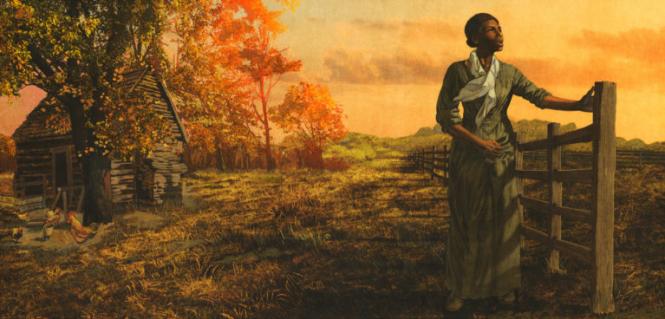“I had reasoned this out in my mind; there was one of two things I had a right to, liberty, or death; if I could not have one, I would have the other; for no man should take me alive.” — Harriet Tubman to Sarah Bradford in Scenes in the Life of Harriet Tubman, 1868.
 True stories of the Underground Railroad come alive in Tubman Travels: 32 Underground Railroad Journeys on Delmarva.
Written by Jim Duffy.
True stories of the Underground Railroad come alive in Tubman Travels: 32 Underground Railroad Journeys on Delmarva.
Written by Jim Duffy.
Spiritually led by dreams and the natural ways of her foremothers, Harriet Tubman only knew freedom as an option. Born Amarinta “Minty” Ross at Dorchester County, Maryland in 1822, Harriet was accustomed to the plight of slavery and oppression. Although the consequences of seeking freedom could be fatal, Harriet Tubman chose self-liberation for herself and her people.
After marrying John Tubman and adopting the name, Harriet Tubman, she escaped the chains of slavery on September 17, 1849. From trapping muskrat in marshlands to working the fields and learning to navigate land by using the sky, Harriet Tubman was able to turn her uncomfortable circumstances into tools of emancipation.
 A bronze statue of Harriet Tubman stands in the Maryland State House.
Image courtesy of Annapolis Discovered.
A bronze statue of Harriet Tubman stands in the Maryland State House.
Image courtesy of Annapolis Discovered.
The Underground Railroad and Beyond
“I never ran my train off the track, and I never lost a passenger." — Harriet Tubman
As the most honored conductor of the Underground Railroad, Harriet Tubman made at least 13 trips back to Maryland to rescue over 70 men, women, and children from the Maryland slave trade. Amongst those freed from the shackles and hard labor were her family and many others.
Her experiences and knowledge from her years of subjugation prepared her for leadership in the Union Army. Harriet’s former contacts, navigational skills, and acute knowledge of the territory and terrain proved formidable assets to the army. Thus, she was selected to serve as an armed scout, spy, and recruiter. Amongst her remarkable list of accomplishments is her contribution to the liberation of over 700 enslaved people in Beaufort, South Carolina. That expedition of the Combahee River Raid deemed her the first woman to lead a military expedition with her regiment, the U.S. Second. She also worked as a nurse and a cook in the Union Army.
 A portrait of Harriet Tubman from the album of Emily Howland.
Image courtesy of the Collection of the National Museum of African American History and Culture
shared with the Library of Congress.
A portrait of Harriet Tubman from the album of Emily Howland.
Image courtesy of the Collection of the National Museum of African American History and Culture
shared with the Library of Congress.
Using her voice and the power of song, Harriet Tubman calmed the spirits of her often fearful and nervous passengers. The latter was most influential in the Combahee River Raid, where many of her people sang themselves toward their freedom.
In 1913, Harriet Tubman was laid to rest in the Fort Hill Cemetery at Auburn, New York. Today, a beautiful bronze reminder of the poise, dedication, and stature of Harriet Tubman adorns the Old House Delegates Chamber in the Maryland State House. The statue depicts Harriet Tubman at age forty-two.
Freedom Bound Exhibit at Banneker-Douglass
Freedom’s call was heard throughout Maryland, including here in Annapolis and all over Anne Arundel County and the Chesapeake Bay Region. The Freedom Bound: Runaways of the Chesapeake exhibit at the Banneker-Douglass Museum highlights nine stories of resistance and escape from the jaws of slavery, bondage, and servitude.

Underground Railroad Network
The Underground Railroad Network spanned through many states, including Kentucky, Virginia, Maryland, Ohio, Indiana, Iowa, and so on. The Underground Railroad was made up of conductors who navigated the terrains and stationmasters who operated the stations, safe houses, and depots. Harriet Tubman navigated people from many towns and cities located near and along the Chesapeake Bay.
The Harriet Tubman Scenic Byway stretches 125 miles from Cambridge to Goldsboro, Maryland. As part of the Great Chesapeake Bay Loop, the byway travels through many towns and landscapes navigated by Harriet Tubman and other conductors.
Looking to learn more about the Maryland stations along the Underground Railroad or other historical records? Visit the Maryland State Archives in Annapolis, Maryland. If you are searching for more information on laws, policies, and legislation concerning the Underground Railroad, visit the Maryland State House in Annapolis.
 Art at Large, Sally Comport illustration for Harriet Tubman Underground Railroad Visitor Center
Image courtesy of Art at Large.
Art at Large, Sally Comport illustration for Harriet Tubman Underground Railroad Visitor Center
Image courtesy of Art at Large.









